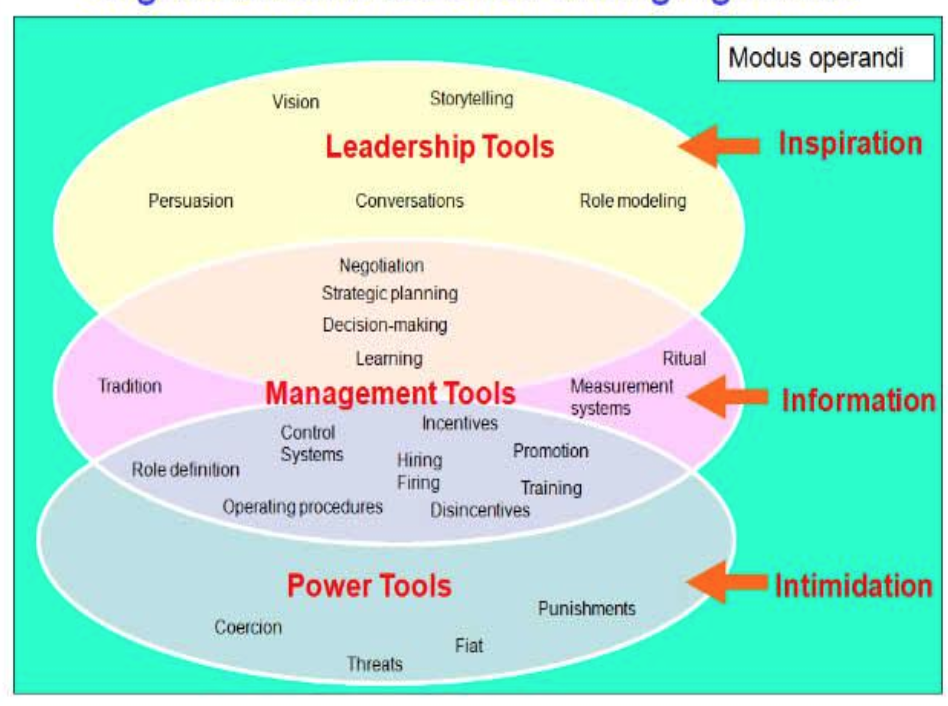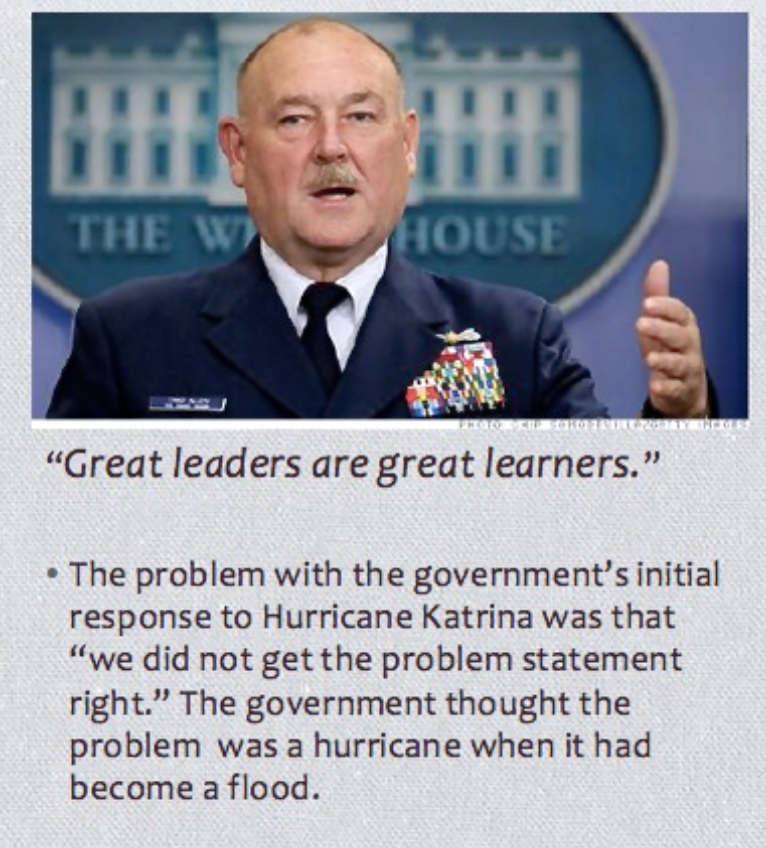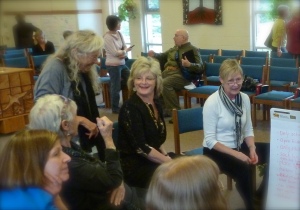
This post features the leadership vs. management thinking of Peter Drucker as well as the distributed power concepts of Open Space methodology, a way to give voice to everyone that is balanced by hidden and overt guidelines and principles inherent to any group or organization.
There’s the often asked question, “What is management vs. what is leadership? This question is more about power and influence, though it continues to be asked. At the time I wrote this originally posted, a web search on the question delivered 176 million results. Today when updating this post, the count is 1,950,000,000 results.
After Dr. John Kotter, Harvard professor and author of several best-selling change methodology books decided to post a short piece on the leadership question, I wanted to share here what the late leadership guru Peter Drucker actually said about the “no such thing as leadership” attributed to him, from someone who knew him well. Drucker’s friend, Wes Balda, wrote about our collective, overwrought attention to defining leadership:
Leading could be how we manage, or make knowledge effective through relationships, in powerless environments.
~ Peter Drucker
Excerpted:
At lunch one day, [Wes] asked Peter to define leadership. He snorted in response, “There is no such thing as leadership.” He defended this by claiming it couldn’t be defined. He stressed that leaders were only labeled thus because they had followers. “At best, leadership may be a dimension of management,” he said, “and leaders could be identified because their actions were predictable, or perhaps trustworthy.” Leading could be how we manage, or make knowledge effective through relationships, in powerless environments.
Wes commented, “When the greatest management thinker of the 20th century expresses his ambivalence about leadership, we should all pay attention. …we are awash in leadership books.”

“…Max DePree also identified an important concept – the absence of power. Leading could be how we manage, or make knowledge effective through relationships, in powerless environments.”
“Results are achieved around or beyond the use of power. ‘Leading without power’ may be the only way leadership works. By definition, then, using power in leading is not leading at all.”
“…using power in leading is not leading at all.”
~ Max DePree, Herman Miller
A leadership, management model published in Forbes around 2012 and republished in 2020 is by Steve Denning emphasizing the power of influence, vision and story. The model places “power tools” at the base. Note the types of tools classified as “Leadership” tools, ones that “pull” in participation and inspire, such as storytelling, vision and conversation, as well as learning, which is listed as a management tool but does not enter the “power tools” and coercion circle. The model is labeled “Organizational tools for changing minds.”

A good test of leadership definition is to look at organizations run by and staffed by volunteers, with no paycheck (or mortgage payment) at risk. Power is still implied in leadership roles. Volunteers themselves may joke about this, like reminders to themselves of the freedom they have. You might hear statements like:
- If I don’t get this done, the “boss” will cut my (volunteer) pay.
- I might get written up (negative note in personnel file) if this doesn’t go well.
- Someone might cut my bonus pay if we don’t make good.
Wes Balda elaborates further on the manager, leader mythology:
Most “leaders,” when they get into trouble, are found to have used power inappropriately and therefore become toxic. So, when Drucker says leaders are only defined by the presence of followers, I believe he means that these followers first exist – and that they are absolutely free from all constraints in choosing to follow. The decision to follow creates the ultimate democracy. (He writes that Drucker became even more focused on civil society after bombing of the twin towers Sept. 11, 2001.)
Sharing power is one reason to explore methods like Open Space Technology, one of several process tools useful in developing agility in organizations. It is also useful for breaking out of management ruts and old thinking . Open Space use processes like Marketplace (photo) to surface topics that draw interest and passion, so that when a group gets into Open Space:
1. The issues that are MOST important to the participants will be raised.
2. The issues raised will be addressed by those participants most qualified and capable of addressing the learning needs on each of them.
Open Space is useful for many things, including implementation of planning, because passion can be great, but it goes nowhere until the feet take it somewhere. Examples of Open Space in action are included in the video below (at the one minute mark) and in Deb’s photo set using Open Space with a large group at the global change conference, ACMP here: Success Secrets of Trusted Change Advisors.

Leadership having mobility to manage across detail and work with the public or full staff or community groups is the skill set needed to emerge stronger in chaos and confusion. The work of Admiral Thad Allen, the retired commandant who led the federal response to hurricanes Katrina and Rita in the Gulf Coast region in 2005-2006 is respected for this reason, as is his actions after the Deepwater Horizon oil spill disaster based on thinking systemically, mentioned in Peter Senge’s “The Fifth Discipline.” There are also insights described in the antifragile writings of Nassim N. Taleb.
In the past a leader was a boss. Today’s leaders must be partners with their people… They no longer can lead solely based on positional power.”
~Ken Blanchard
Leadership itself could be best set free from roles and instead attached to leadership moments. Laying out too much exhibited power, not enough influence causes the malaise of over-managing and intimidation listed in the model above. Needed partnerships with others is a nuanced dance of helping others shine in their leadership moments, as well as knowing when it is your turn.
Think of leaders in countries experiencing great unrest and conflict. In 2022 it includes Ukraine and includes both the greatly admired and the reviled. These leaders have followers that make the difference. Reputation and sense of community matter in history, and in today’s sensibilities regarding Open Space Technology (methodology), Liberating Structures and Preferred Futuring:
- Catherine the Great, 1729-1796, improved the lives of Russian serfs and helped elevate Russia as one one of the dominant countries in Europe
- Abraham Lincoln, 1809 -1869, 16th president and leader through the US Civil War of fought from 1861 to 1865
- Saddam Hussein, 1937 – 2006, 5th president of Iraq, condemned widely for his brutal style of dictatorship
- Nelson Mandela, 1918 (age 94), anti-apartheid activist and President of South Africa from 1994 to 1999, the first to be elected in a fully representative democratic election, avoiding bloodshed and civil war.
- Lady Gaga, 1986 (age 26), American singer & entertainer with over 26 million followers in 2013, “Little Monsters” and respected in 2022 as she works with aging stars like Tony Bennett and Liza Minnelli.
- Ukraine’s president, Volodymyr Oleksandrovych Zelenskyy, who’s leadership during the invasion of his country by Russia has won him widespread international praise. He has been described as a symbol of the Ukrainian resistance.
Finally, the classic video about the first follower shows the amazing power of informal leadership, or leadership at any level of the organization:
Learn more about participative processes, leadership moments, have a chat. Contact Deb via email or phone here.
References and Related Posts:
- Leadership during Turbulent, Complex Times
- Wesley Balda, There is no such thing as leadership. Features how to define leadership as a distinctive dimension within the larger domain of management. Refers to the views of recently deceased international management guru Peter Drucker. 2011
- Beyond Resilience: Givers, Takers, Matchers and Anti-Fragile Systems
- Beyond Resilience: Black Swans, Anti-Fragility and Change
- Co-Creation in Theory U: Leading from the Future as it Emerges & the Road to Commitment
 This work is licensed under a Creative Commons license. It was originally written in 2013. It was updated in format and for readability in 2022.
This work is licensed under a Creative Commons license. It was originally written in 2013. It was updated in format and for readability in 2022.


You have a great video clip about open space and it gives good visuals of the process!!! Open space is a great way to get people collaborating and sharing in a different ways. We have used this process several times in our organization. When people are allowed to go where they feel energy and not directed or told what to do, the outcomes are amazing.
Thanks for sharing such good information!!
LikeLike
Julia, I hope you’ve had some opportunities to experience Open Space since January when we talked. If you have, it would be great to know about the outcomes.
My last experience with Open Space in a business setting is that it helped a sizable group of volunteers who were dissatisfied with a leader decision to let go of a majority of the simmering angst of that decision and move on to productive planning. Follow-up assessment showed that the group had successfully pivoted or shifted into a new, more productive mindset. Such is the stuff of letting go of traditional power!
~ Deb
LikeLike